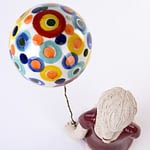
Philipp Schweiger (AUT), Hisa Enomoto (JAP)
Curated by Lucas Cuturi
The idiom “The same in green” serves the German language as a tool for the description of objects and circumstances which, apart from a few differences, have the same or a similar, if not even the same meaning.
In this case, the phrase refers to the works of two young artists who deal with the theme of landscape. However, they do so from the basic understanding of their respective cultural backgrounds.
At first glance, Japan and Austria do not really have much in common. At second glance, however, one realizes that both countries are strongly influenced by their varied natural landscapes. The mountain world has a significant influence on the living conditions and culture of both countries.
Schweiger approaches the topic of landscape, which has been established in European art since about the middle of the 16th century, in a very playful way.
Schweiger chose the technique of collage as one of the mediums of his art. He composes new worlds by carefully selecting views from various illustrated books and magazines that match his mood and appearance. Like the painters of Romanticism, he created ideal landscapes which, however, were not adorned with staffage figures and ancient ruins, but with civilizing achievements such as cars, reservoirs, motorways, etc.
Schweiger reinterprets for himself the Bible quotation: “Make the earth your subject” (Genesis 1:28) by questioning the existing reality ironically and with the help of consciously inserted irritation and putting it in a new light.
In contrast to the very individual approach to the subject in European art, in which man feels himself to be the crown of creation, Enomoto encounters the subject in a traditional Japanese way, which understands man as part of nature.
Shan-Shui painting (mountain/water), the term for landscape painting, has been widespread in East Asia since the 8th century (mainly in China and Japan).
Enomoto’s paintings appear airy and unobtrusive. She uses the traditional technique of “Sumi-é”, a kind of ink or watercolour painting that has been used in Japan since the 16th century, as well as the oil painting commonly used in the West.
The themes she picks up are mainly of a personal nature. These are memories from her childhood, but also impressions and experiences she gained in the mountains of Tyrol.
Text: Lucas Cuturi
Exhibition period June 2010
Location: Kunstverein: Glockengasse No 9, 1020 Vienna
www.glockengasse9.net
www.philippschweiger.com
www.hisaenomoto.com












